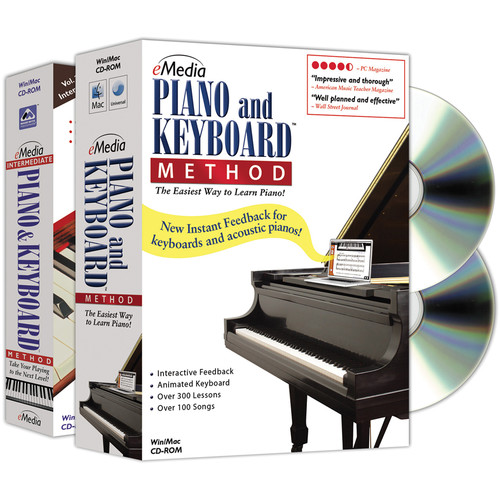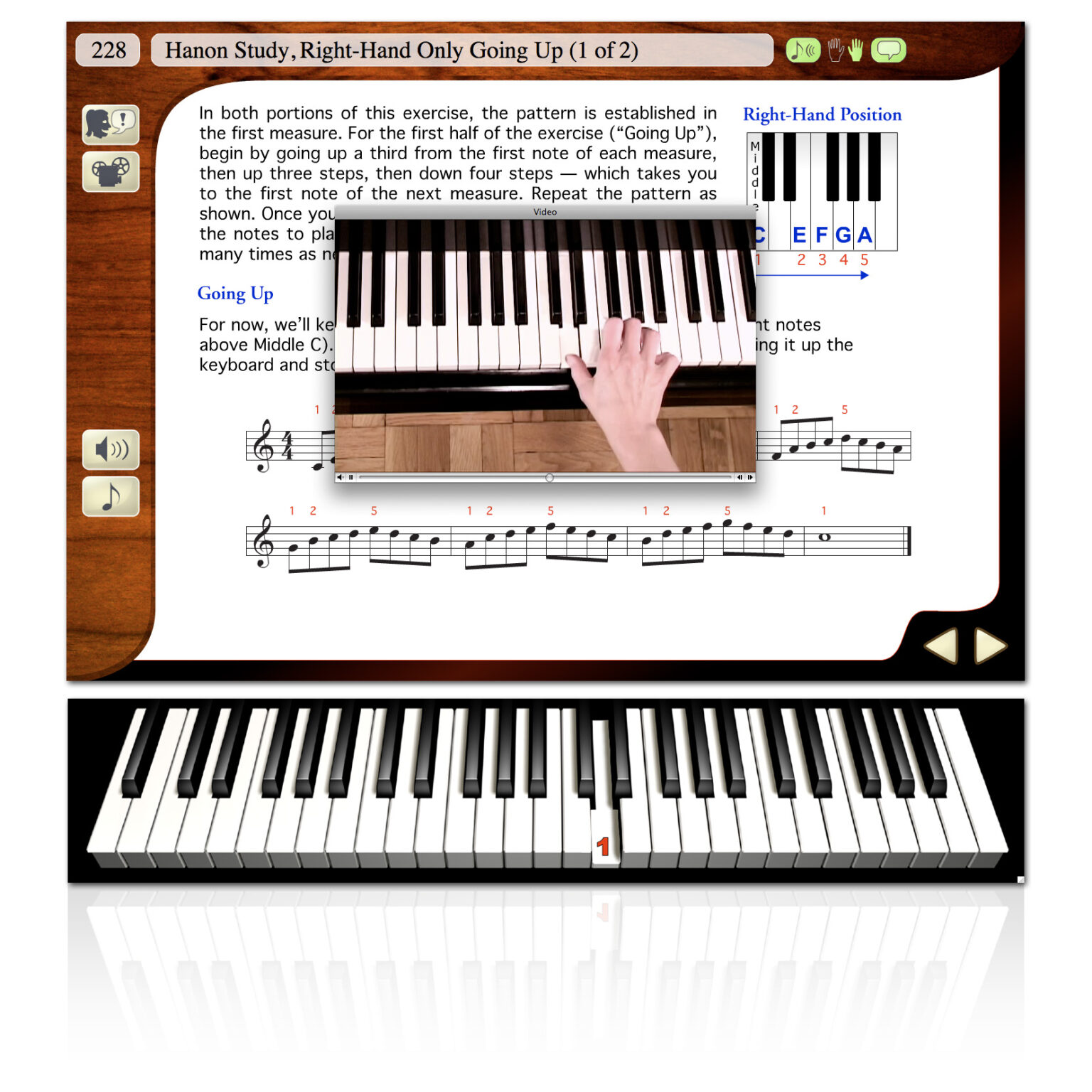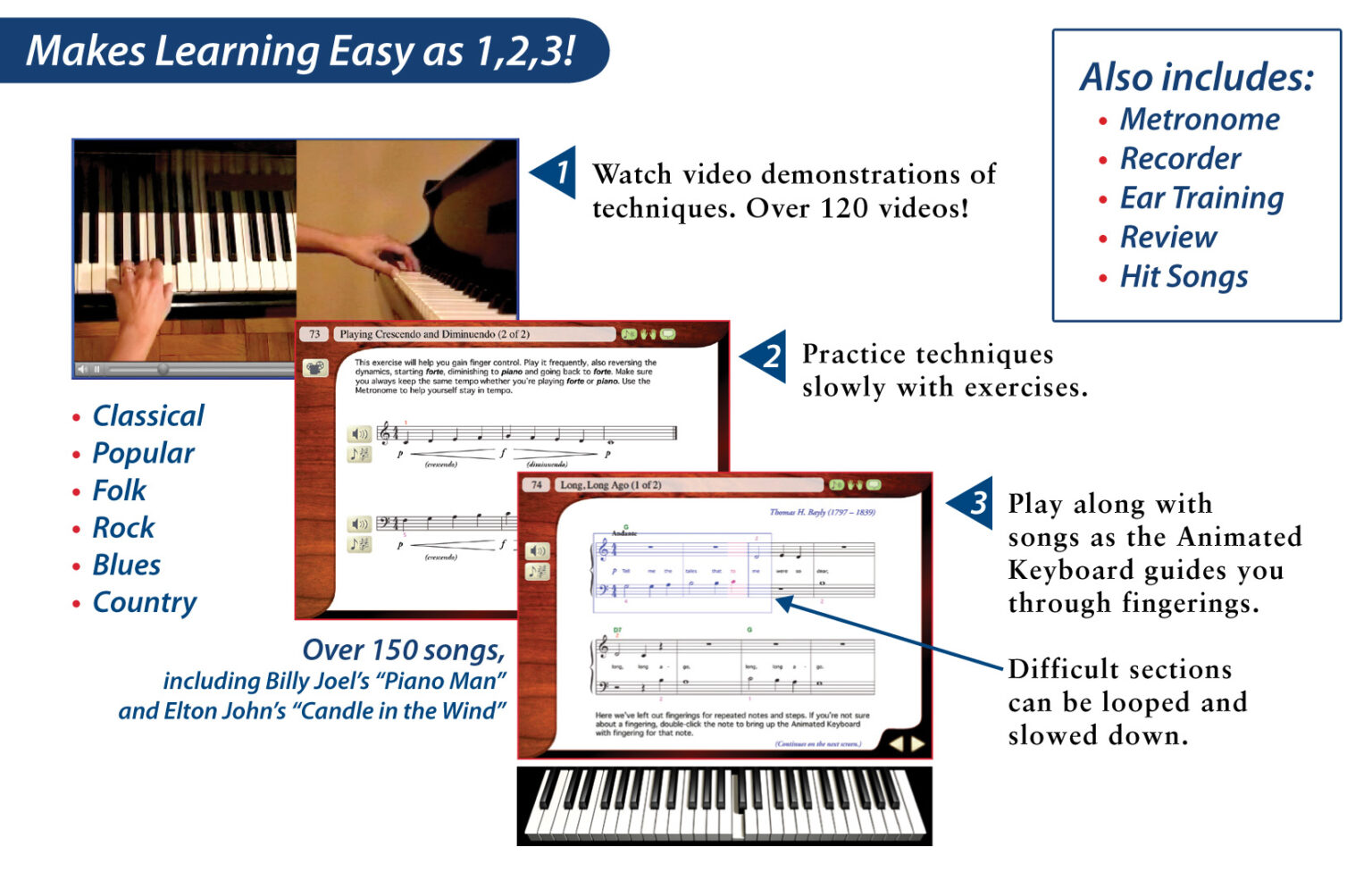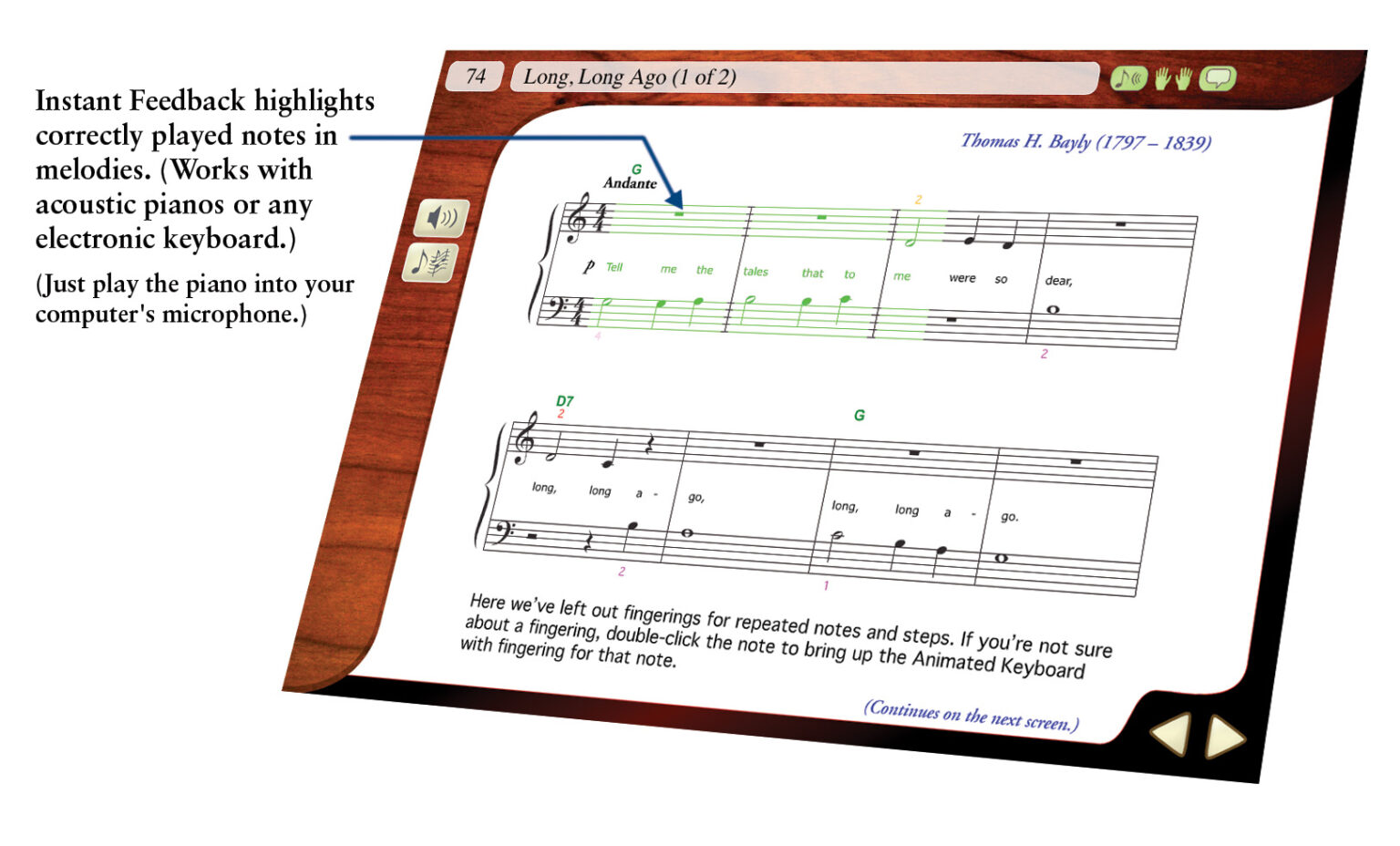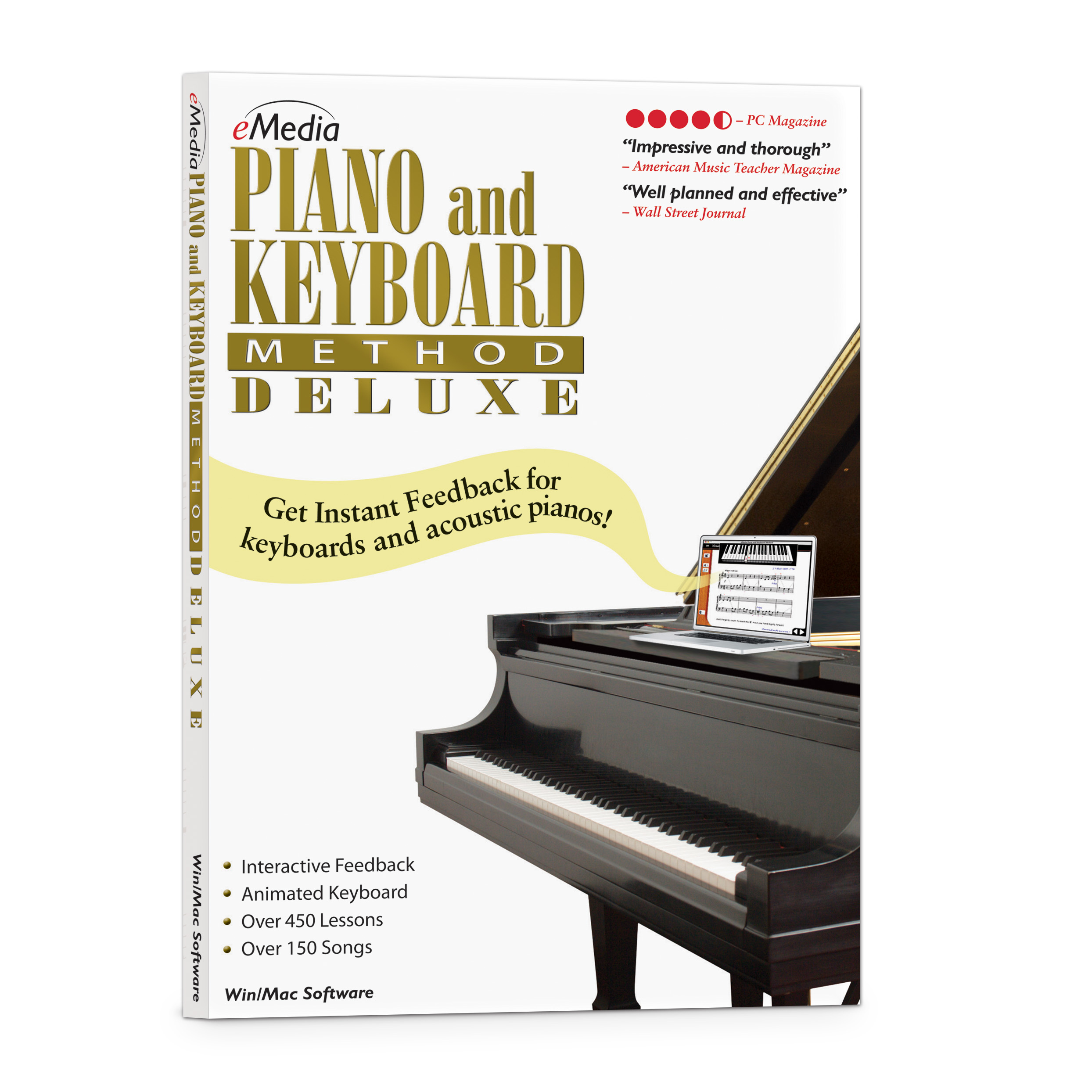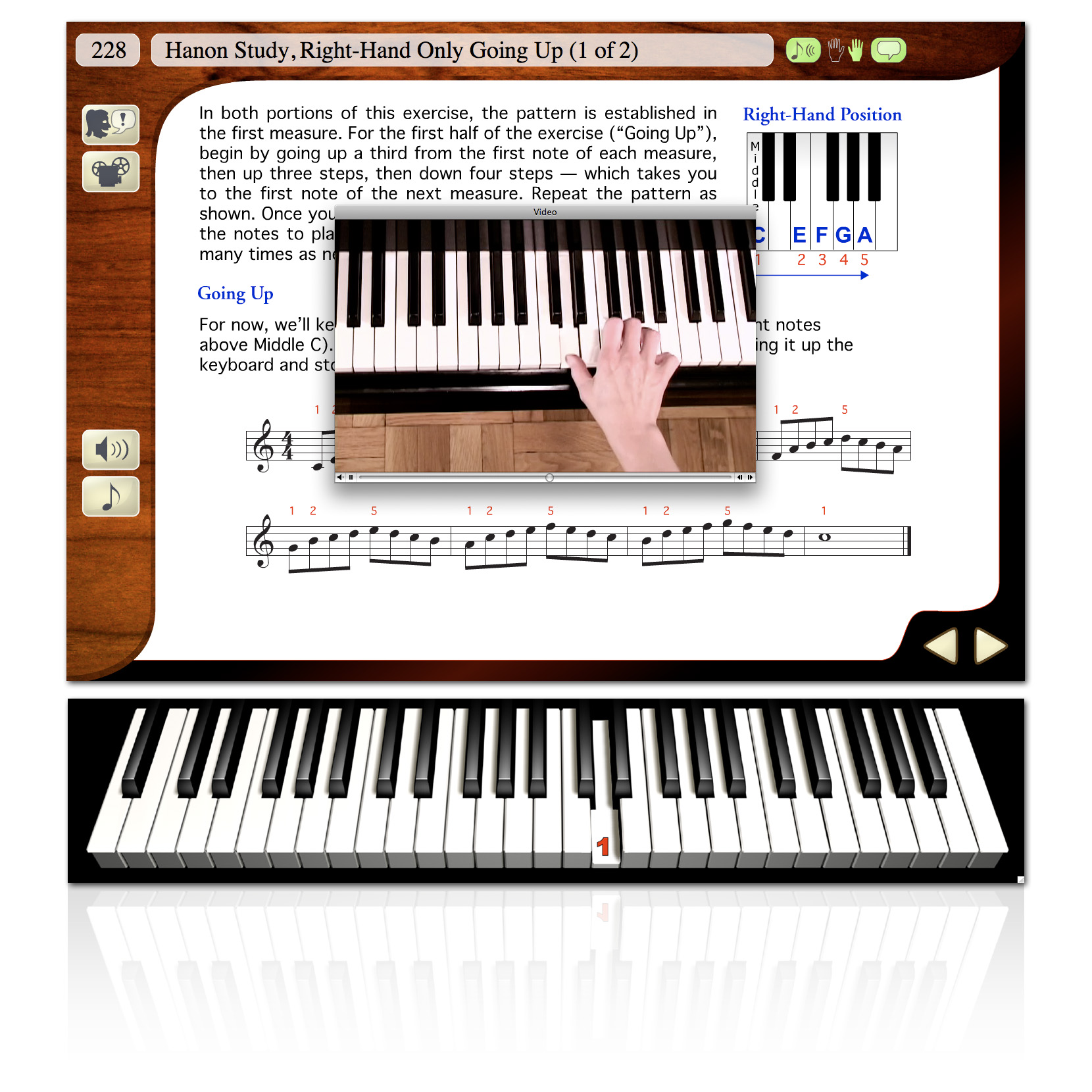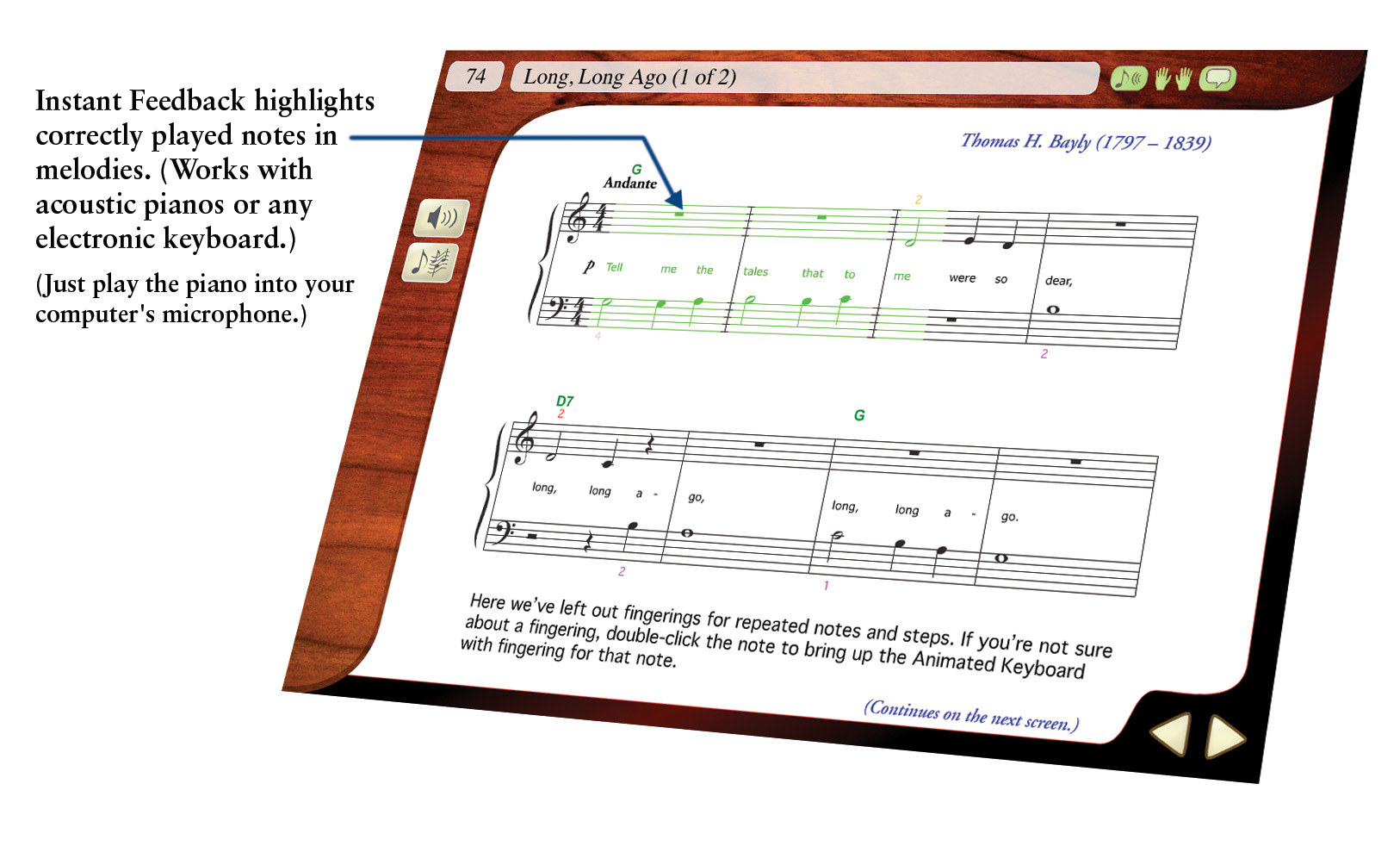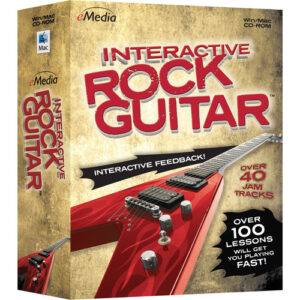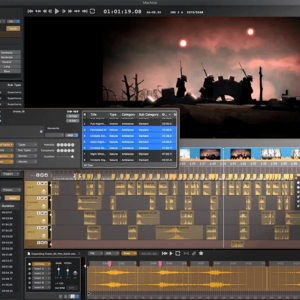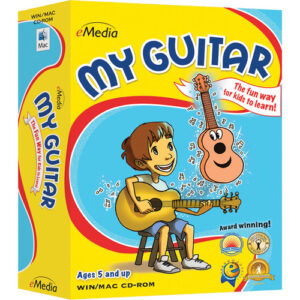MMS: 919 •
MPN: EK02131DLM •
SKU: 1097-16
eMedia Music Piano and Keyboard Method Deluxe for Mac (Electronic Download)
Authorized Dealer
In Stock
$79.95
100 in stock
Features
• Two Tutorial Programs in One Package
• Piano and Keyboard Method
• Intermediate Piano and Keyboard Method
• Over 450 Lessons and 120 Videos
Description
With Piano and Keyboard Method Deluxe for Mac in electronic download format from eMedia Music, you get both the Piano and Keyboard Method and Intermediate Piano and Keyboard Method tutorials in one package. You’ll learn how to play piano or keyboard and benefit from feedback on how you are doing. With over 450 lessons, 120 videos, and more than 150 songs in various styles at your disposal, you’ll come away knowing how to play some of your favorite tunes regardless of whether you’re using a concert piano or a MIDI keyboard.You’ll be playing in no time by following the Animated Keyboard as it displays correct finger positions while the music plays or for any note or chord you choose. When used with a MIDI controller, the program provides specific feedback on playing mistakes, including wrong notes and rhythms. Other features include a metronome, recorder, variable-speed MIDI keyboard tracks, accompaniment tracks, and ear training exercises. You will also receive interactive performance evaluations to help you keep track of your progress.Piano and Keyboard Method Deluxe is taught by onscreen instructors Irma Irene Justicia, M.A. and Vadim Ghin, M.M., who provide clear and friendly direction.
Over 450 step-by-step piano lessons arranged in thirty chapters across two tutorial programs. The lessons cover the basics such as hand position, rhythm, and playing on black keys, then move on to more advanced concepts like music notation, sight reading, intervals, chords, scales, developing manual dexterity, advanced rhythms and transitions, interpretive expression marks, the blues, improvisation, and ensemble performance.
eMedia’s Animated Keyboard lets you see color-coded fingerings for all of the piano lessons, including piano chords, piano scales, and songs. See exactly how to play the song on a keyboard as you hear the music. Music tracking highlights notes or chords as they are played, making it easy to follow along.
Interactive feedback with Note and Finger Tracker allows the piano software to listen as you play melodies and display your playing accuracy. This tool for beginner piano instruction works with both electronic keyboards and acoustic pianos. Feedback balloons point out and correct mistakes in notes or rhythm. After you click on the balloon, the animated keyboard shows you the corrections. Learn to fix mistakes and read music faster. Interactive feedback works when using an electronic MIDI-compatible keyboard in Piano and Keyboard Method, and when doing selected exercises in Intermediate Piano and Keyboard Method.
- Interactive Performance Evaluation in the piano software highlights your playing mistakes and shows what you should have played with an overall percentage score, provided you are using a MIDI keyboard. In Piano and Keyboard Method, personalized reports show your rate of progress, including scores for specific songs, when using a MIDI keyboard.
- Lessons on piano basics like how to read piano music, playing accompaniments with piano chords, piano scales, and more.
- Over 120 videos for the piano lessons are included. Split-screen views with close-ups are available for many of the videos in order to show you proper piano fingering and hand positioning. You can also view in full-screen mode. The videos are larger and the quality has been enhanced in this version as well.
- Piano lessons include easy piano songs as both audio and MIDI tracks, in which selections can be looped, slowed, or sped up. Highlight an entire page or just a portion of a song, and loop it for playback at whatever speed you are comfortable playing. Selected loops are now introduced with the MIDI tick count-off, so there’s enough time to get your hands back to the keyboard to play along. This means you can follow along regardless of what section of the piece you’re working on.
- Accompaniment tracks for all piano songs. Selected pieces in Intermediate Piano and Keyboard Method include orchestral and jazz band accompaniment.
- A digital metronome keeps you on rhythm and helps you work on speed and timing. It provides visual cues and/or audio ticks, along with a full range of tempi from largo to presto. A digital recorder helps you gauge progress and share your playing with others.
- With the click of a button in Piano and Keyboard Method, you can get suggestions about which voice to use on your MIDI keyboard to get the best sound for the song.
- Over 150 popular classical, blues, pop, and rock songs, including Billy Joel’s Piano Man, Bob Dylan’s Knockin’ on Heaven’s Door, Los Lobos’ La Bamba, Elton John’s Candle in the Wind, Spencer Williams’ Tishomingo Blues, and Scott Joplin’s The Entertainer, plus classical piano pieces like Franz Liszt’s Hungarian Rhapsody, Pyor Ilich Ychaikovsky’s Swan Lake, Paul Dukas’s The Sorcerer’s Apprentice, and Beethoven’s Ode to Joy and Ecossaise.
Remaining songs in Piano and Keyboard Method include the following:
- Air (Mozart)
- Alouette
- Amazing Grace
- America (My Country ‘Tis of Thee)
- America the Beautiful
- Au Clair de Lune
- Aunt Hagar’s Children Blues
- Aura Lee
- Babylon’s Fallin’
- Barcarolle (Offenbach)
- Blue Mood
- Busy Crab
- Cathedral Bells
- Chiapenecas
- Choppy Sailing
- Circus is Here!
- Country Gardens
- Cuckoo
- Cuckoo and the Donkey
- Deck the Halls
- Dreydel
- Entr’acte from Rosamunde (Schubert)
- For He’s a Jolly Good Fellow
- Galop from Orpheus in the Underworld (Offenbach)
- Gavotte (Lully)
- Give my Regards to Broadway
- Go Tell Aunt Rhody
- Good Morning to You
- Happy Scale
- Harmonic Interval Song
- Home on the Range
- Hot Cross Buns
- Hot Day on the River Boat
- Humoresque Theme (Dvorak)
- Humoresque Theme (Tchaikovsky)
- Humpty Dumpty
- I’m Feelin’ Blue
- I’m a Little Teapot
- If You’re Happy and you Know It
- In the Clouds
- In the Evening by the Moonlight
- Interval Song in F
- Interval Song in G
- Jingle Bells
- Jolly old Saint Nicholas
- Joy to the World
- Kumbaya
- La Donna e Mobile (Verdi)
- Lavender’s Blue
- Li’l Liza Jane
- Lightly Row
- Long, Long Ago
- Love Somebody
- Lullaby (Brahms)
- Marathon Runner
- March
- Marine’s Hymn
- Mark is Jumping
- Mary Had a Little Lamb
- Melancholy Flats
- Melodic Interval Study
- Melody (Diabelli)
- Michael, Row the Boat Ashore
- Minuet (Paderewski)
- Minuet in G (Bach)
- Molly Malone
- Motion
- Musette (Bach)
- My Park Carousel
- New World Symphony
- Noble Duke of York
- O Come all ye Faithful (Adeste Fideles)
- Oats, Peas, Beans and Barley Grow
- Oh my Darling Clementine
- Oh, Susanna
- Old Grey Mare
- Paris Waltz
- Playful Little Waltz
- Pop! Goes the Weasel
- Red River Valley
- Rhythm, Rhythm
- Rockin’ Scale
- Romanze (Beethoven)
- Round Dance (Bartok)
- Row, Row, Row Your Boat
- Scale Tune
- See Saw
- Skip and Hop Tune
- Skipping Tune
- St. Anthony’s Chorale (Haydn)
- Surfer
- Surprise Symphony (Haydn)
- Swanee River
- Swinging up and Down
- Symphony No. 89 (Haydn)
- Three Blind Mice
- Treadmill
- Trio (Beethoven)
- Trumpet Voluntary (Clarke)
- Turtle Waltz
- Twinkle, Twinkle Little Star
- Up and Down the Ladder
- Wedding March (Wagner)
- When the Saints go Marching In
- Winter, Goodbye
Remaining songs in Intermediate Piano and Keyboard Method include the following:
- A Little Night Music (Eine Klein Nacht Musik)
- Aria
- Aura Lee
- Ballade No. 4 (Chopin)
- Bourree
- Cello Sonata
- Charlie’s Romance
- Chime Blues
- Clementine
- Danny Boy
- Danny Boy Blues
- E Lucevan le Stelle
- Ecossaise
- Fourth Ballade
- Funiculi Funicula
- Greensleeves
- Gypsy Blues
- House of the Rising Sun
- Hungarian Dance
- Hungarian Rhapsody
- Jelly Roll Blues (Jelly Roll Morton)
- Jesu, Joy of Man’s Desiring
- Kate Kearney
- Kufstein
- Lacrymosa
- Livery Stable Blues
- Lonesome Mama Blues
- Lullaby
- Mozart’s Piano Concerto No. 21 – Movement 1
- Mozart’s Piano Concerto No. 21 – Movement 2
- Naa Yanga
- No End Blues
- Outlandish Knight
- Polovetsian Dance
- Pomp and Circumstance
- Prelude to an Afternoon of a Faun
- Rachmaninoff’s Piano Concerto No. 2
- Rachmaninoff’s Piano Concerto No. 3
- Rainy Day Blues
- Rakes of Mallow
- Romanza
- Rondo Theme
- Sarabande
- Scherzo
- Schoolhouse Blues
- Serenade
- Shenandoah
- Slavic March
- Something’s Come Over Me Blues
- Sorcerer’s Apprentice
- St. Louis Blues (W.C. Handy)
- The Schoolhouse Blues (Irving Berlin)
- The Swan
- Symphony No. 4
- Tarantella – Neopolitana
- Themes from Symphony No. 6
- Third Piano Concerto (Rachmaninoff
- Trio No. 1 in A Minor
- Trio No. 2 in C Major
- Turkey in the Straw
- Twenty-First Piano Concerto (Mozart)
- Un Bel Di
- Wachet Auf
- Walking Away
- War Bride Blues
- When Johnny Come Marching Home
- Why Cry Blues
- Wicked Blues
- A piano tutorial on improvisation that teaches music theory and the relationship of piano scales to piano chords.
- Contains an introduction to blues piano.
- Guitar chords are included so that a friend can accompany you. Piano fingerings and guitar chords can be toggled on or off for any screen.
- Song looping lets you highlight and repeat any section of music you wish to practice.
- Taught by onscreen instructors Irma Irene Justicia, M.A. and Vadim Ghin, M.M., who provide clear and friendly direction. Instructor advice is only a click away whenever you need it.
- Enjoy hours of live recorded multitrack audio performances. Live recorded audio is included for all songs and exercises. Audio playback options include piano only, voice only, and full audio featuring both piano and vocal performances.
- Slow the music down as you like with variable-speed MIDI tracks. With MIDI playback options, you can select left or right hand only or choose to playalong with a metronome click track. Colorful variable-speed MIDI accompaniments are also available.
Intermediate Piano and Keyboard Method Contents Summary
- Introduction
- I. Tonality and the Keyboard: Pitches; Key Signatures; Intervals; Expanded Hand Position; A Minor Scales and Chord Progression with Inversions; Hanon and Other Finger Exercises; Pieces Include Works by Beethoven, Liszt, Tchaikovsky and Traditional Songs
- II. Developing Manual Dexterity and Independence: Complete Note and Rest Values; E Minor Scales and Chord Progression with Inversions; More Intervals; Hanon and Other Finger Exercises; Independence of Hands; Pieces Include Works by Beethoven, Bach, Mozart, Puccini, Brahms and Traditional Songs
- III. Advanced Rhythms and Transitions: Triplets; More Intervals and Chords; Etudes; Changing Time Signatures; Pieces Include Works by Schubert, Bach, Mozart, Brahms, Debussy, Tchaikovsky and Traditional Tunes
- IV. Interpretive Expression Marks and Voicing: Expression Marks; Closed and Open Voicing; D Minor Scales and Open Chord Progression; Philipp Exercise for the Independence of Fingers; More Intervals; Pieces Include Works by Puccini, Tchaikovsky, Dukas, Saint-Saëns, Brahms, Borodin, Traditional Tunes and More
- V. Integrating Elements of Performance: More Intervals; The Diminished Chord; Hanon for Wrist Technique; Etude; Rubato; Pieces Include Works by Elgar, Handel, Chopin, Mouret, Mozart and Traditional Tunes
- VI. The Blues: The Blues Form, Scales and Progressions; Swing Rhythm; Grace Notes; Glissandos; Blues Songs Include Works by Fletcher Henderson, Jimmy Durante, Eubie Blake, Perry Bradford, W.C. Handy and Others
- VII. Improvisation Based on the Blues: Melodic, Rhythmic and Harmonic Improvisation; Walking Bass, Stride, Swing (Boogie Woogie and Other Variants), Rhythmic Repetition, Funky Rhythm; Jam Along and Make Up Your Own; Pieces Include Works by Irving Berlin, George Gershwin and Jelly Roll Morton
- VIII. The Piano in Ensemble: Warshauer’s Rainy Day Blues with Jazz Ensemble; The Piano Concerto with Orchestral Accompaniment (Extended Excerpts): Mozart’s Piano Concerto No. 21 (First and Second Movements); Rachmaninoff’s Piano Concertos No. 2 and No. 3
- Developing Finger Dexterity: Exercises for 2, 3, and 4 Fingers; Hanon Exercise No. 1 in C Major, A Minor, F Major, D Minor, G Major, E Minor; Philipp’s Independence of Fingers Exercises No. 1 and No. 2
- Supplementary Scales and Intervals: Two-Octave Scales: C Major, A Minor, F Major, D Minor, G Major, E Minor; Summary of Interval
- Review of Piano Basics
- Appendix
Piano and Keyboard Method Contents Summary
- Introduction
- I. Playing on Black Keys – Rhythm: The Piano and Keyboard; Direction of Sound; Counting and Time Signatures; Improvisation on Black Keys with Rhythmic Flashcards; Playing Songs on Black Keys
- II. Playing on White Keys – Notes: Introducing Note Reading; Playing Songs on White Keys in Middle C Position
- III. Tempo, Dynamics and Sight Reading: Tempo Markings; Dynamics Markings; More Songs in Middle C Position; Sight Reading with Twisted Melodies
- IV. Both Hands Playing Together: Playing Accompaniments: Songs with Both Hands Playing Together in Middle C Position; the Sharp, Flat and Natural Signs
- V. Legato and Staccato: More Songs in Middle C Position; Counting Dotted Quarter Notes; Playing Legato, Staccato and the Two-Note Slur
- VI. The C Position and Intervals: Introducing Melodic and Harmonic Intervals; Playing Songs in C Position; Creating Melodies and Harmonies
- VII. Chords and Triads: Introducing Chords and Triads; More Songs in C Position; The C and G7 Chords; How To Make Your Own Accompaniment Using the C and G7 Chords; Broken Chords
- VIII. The G Position and Transposition: The G Position: Melodic and Harmonic Intervals; The G and D7 Chords; Playing Songs in G Position; How to Transpose a Song
- IX. The F Position and Hanon: The F Position: Melodic and Harmonic Intervals; The F and C7 Chords; Playing Songs in F Position; Transposing from F to C; Hanon Study
- X. C Major Scale and I-IV-V7 Chord Progression: Extending the Hand Position, New Melodic and Harmonic Intervals; How to Play Scales; The C Major Scale; C Major Chord Progressions; Songs Using New Intervals, C Major Scale, and Chord Progressions
- XI. G and F Major Scales, Chords and Arpeggios: The G Major Scale and Chord Progressions; Songs in G Major; The F Major Scale and Chord Progressions; Songs in F Major; How to Use the Pedal; Hands Crossing Over with Arpeggio Songs in C, G, and F Major
- XII. A Short Trip into the History of Music: Famous Melodies from the Baroque, Classical and Romantic Periods, and 20th Century American Music: Ragtime, Blues, Rock; Patriotic and Holiday Songs

